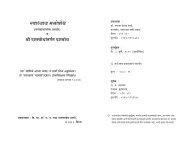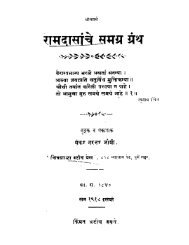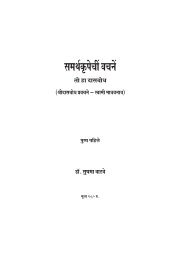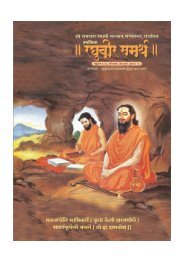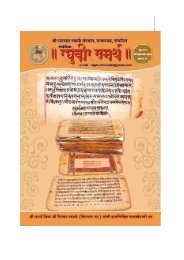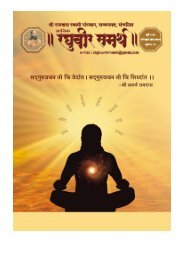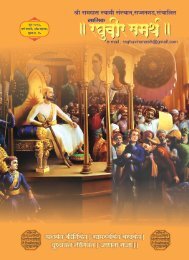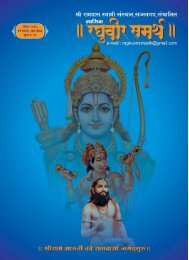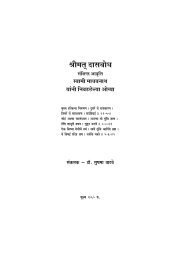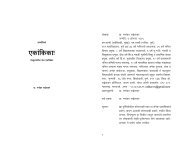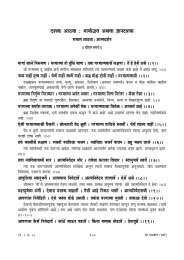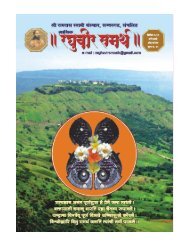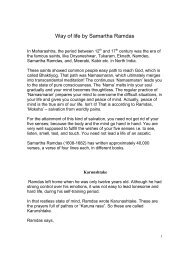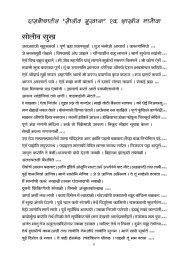THE DASBODHA BY: SADGURU SHREE SAMARTH RAMDAS ...
THE DASBODHA BY: SADGURU SHREE SAMARTH RAMDAS ...
THE DASBODHA BY: SADGURU SHREE SAMARTH RAMDAS ...
You also want an ePaper? Increase the reach of your titles
YUMPU automatically turns print PDFs into web optimized ePapers that Google loves.
and all the feelings associated with them to unify with the God. All these types of Mukti are there<br />
for your taking when you worship the God with all your might.<br />
END OF <strong>THE</strong> NINTH SAMAS<br />
<strong>THE</strong> TENTH SAMAS – MUKTICHATUSHTYA (FOUR TYPES OF MUKTI)<br />
Shree Samarth says that the Parbrahma is expressionless and<br />
formless. There is no place in the Parbrahma for this visible illusion of the universe. From the<br />
original Parbrahma a wave of pride emanated which gave rise to the five basic principles or the<br />
elements, a process described in details in the tenth Dashak. This wave was very powerful which<br />
gave rise to the biggest ever luminescence from which water was formed which is found all over<br />
the earth. The earth itself is protected by the masters of the eight directions. There is a big mountain<br />
at the center of the earth which supports the earth. Then he describes two of the most revered places<br />
in India, the Badrikashram (Badrinarayan) and the Kedarnath as the places where the Saints and<br />
Sages go to breathe their last so that they stand a better chance of getting to the God. (People in<br />
Modern India visit these places very religiously) Then he tells that there are three great mountains;<br />
each of them occupied by the three most powerful Gods of the Hindu religion Lord Brahma, Lord<br />
Vishnu and Lord Mahesh. The place of Lord Brahma is called as the place consisting of the truthful<br />
people, that of Lord Vishnu the Vaikunth and that of Lord Mahesh the Kailas (This Mountain now<br />
is in China and is called so whereas the other two haven’t yet been found, which might be in some<br />
as yet unknown terrain of the Himalayas) He describes these places as Heaven. (Any place in the<br />
Himalayas is still known in India as heavenly and is stamped and acknowledged by foreign visitors<br />
as such). All the Gods stay there. He says that words fall short if one tries to describe these places<br />
and the people inhabiting them.<br />
Then Shree Samarth describes the first type of Mukti as that one in<br />
which people, who worship the God traditionally worshipped by their ancestors; get to stay with<br />
that God. Getting to live alongside the Gods in their own land is the second type of Mukti. The<br />
third type of Mukti is the one where you get the form of the God so that you become a demigod<br />
yourself. In all these types of Mukti you get a chance, and just that, but you aren’t unified with<br />
either the God or the Parbrahma. The time period for which you get this chance is proportional to<br />
the amount of good deeds you have done when you were alive and once that is over you are born<br />
again to undergo the same cycle of birth and death once more or may be for many more times. You<br />
do enjoy the heavenly pleasures but for a limited time. Therefore Shree Samarth says that all these<br />
three types of Mukti are subject to destruction whereas the fourth type is everlasting. In short he<br />
means that if your worship hovers around only in the perimeter of the Maya, the expressed or the<br />
visible and you never acquire the real knowledge then you get any of the first three types of Mukti<br />
after death. At the time of destruction, the whole universe is destroyed along with the Gods and that<br />
being so when the Gods themselves are subject to destruction the first three types of Mukti being<br />
related to God are also liable for destruction and hence are short lived. The only thing that is never<br />
ever destroyed is the Parbrahma and therefore constant yearning for the Parbrahma and the aim of<br />
becoming unified with it after the unification with the God leads one to know thy real self and be<br />
for ever in the state of remembrance of that Atman and/or the Parbrahma; yields the fourth type of<br />
Mukti which is ever lasting as is the Parbrahma. In this Mukti you become finally united with the



